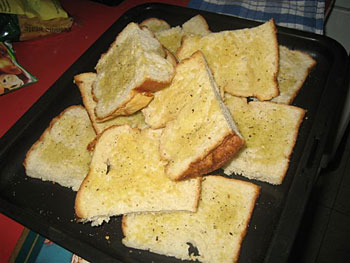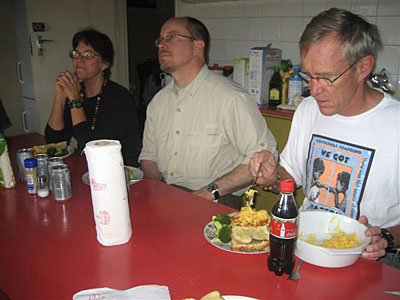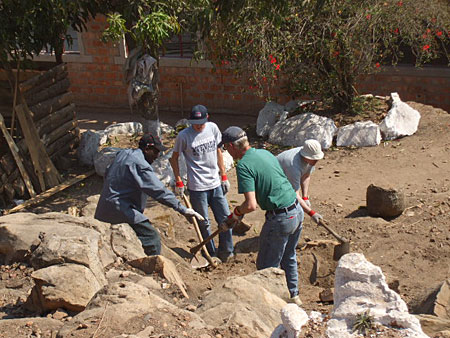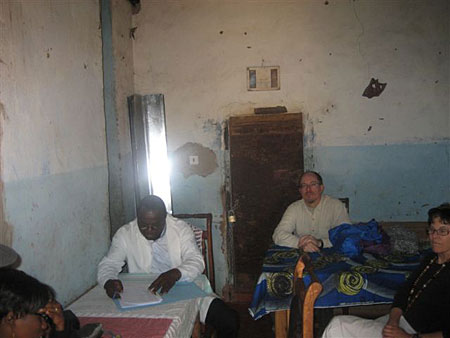Today started with some domestic chores, then lunch at the Big House. There seemed to be a pattern forming of electricity at lunchtime and no electricity at dinnertime, so we decided to go with the prevailing current and have our dinner in the Buddhist tradition, for lunch. Our meal (lunch or dinner or breakfast for those still on U.S. time) was red sauce with tofu over penne, broccoli, and the long awaited Party Bread, which had been cut up and made into garlic bread. Definitely worth waiting two days for.

The long-awaited Party Bread.

Enjoying the meal.
After eating we quickly cleaned up so we could fit in a walk to Strawberry Cafe for some internet access, coffee, and those famous peanut butter milk shakes before going to Kantolomba. The walk took us through a beautiful neighborhood with lots of green lawns, trees, and flowers. We discussed our day's visit to Kantolomba, where Scott, M.D., and Karen, R.N., would sit in on Dr. Obi's patient visits while the steps team continued work on their project.
We found great seats outside at the cafe, but alas, no internet. The sky was uncharacteristically cloudy and it looked like rain, but Friday assured us that was impossible. Even when the clouds are very dark, it never rains in the dry season.
In Kantolomba, we arrived to another happy welcome. The steps team immediately got to work, and the remaining folks met with Theresa to discuss the plan for the next day, which included finding chairs, making a Living Compassion banner, and deciding on decorations for the building celebration scheduled for Tuesday. As we met we noticed that patients were arriving, the first an old man walking with the support of two women. They sat in the shade to wait. Soon Dr. Obi arrived with his wife Carol, also a nurse. He greeted us all warmly and seemed especially interested to meet Scott and Karen, fellow medical people. Together they went into the make-shift health assessment room, and soon Theresa began bringing in the patients one by one. Dr. Obi visits only once a month, seeing ten patients during each trip; it is important to make sure the people being seen are the ten most in need.

The steps team back at work.

Dr. Obi and nurse Carol arrive.
The clinic is held in the one building that was on the property when it was purchased: a cement structure with a tiny window and, today, due to a "brown out," no electricity. It's very dark inside and it takes a bit to adjust to the dimness; the door is left ajar for light. Dr Obi has six new patients today. The first is a 53-year-old man who looks 75 or 80, is obviously not feeling well, not moving well, and complaining of leg pain. He has a history of a stroke. Carol takes his blood pressure, which is 230/130--dangerously high. A taxi is immediately called to take him directly to the hospital. A "bypass fee" is paid so that he can be seen on arrival without having to go through the red tape of first being referred by a local clinic.

Inside the medical room.
